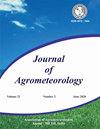Influence of weather factors on population dynamics of major insect pests in moringa (Moringa oleifera Lam.) in south Tamil Nadu
Q3 Agricultural and Biological Sciences
引用次数: 0
Abstract
The field experiments were conducted to study the relationship of major moringa pests infesting buds (budworm), flowers(ants) and pods (podfly) with weather factors (maximum and minimum temperature and relative humidity and rainfall) during the rabi-summer and kharif seasons of 2021 and 2022 in Dindigul district, Tamil Nadu. The pest population data indicated that the infestations were found to vary with the seasons as well as years. The correlation with weather parameters revealed that the budworm infestation was significant and positively correlated with maximum temperature (r= 0.459***) and negatively correlated with morning relative humidity (r= -0.277*), evening relative humidity (r= -0.584***) and rainfall (r= -0.459***). While in infestation by ants, it was positively correlated with the maximum temperature (r=0.42**) and minimum temperature (r= -0.296*), relative humidity (evening) (r= -0.649***) and negatively correlated with rainfall (r= -0.382**). The moringa pod fly infestation had a strong significant positive correlation with relative humidity (evening) (r= 0.7***) and rainfall (r= 0.517***) and a negative correlation (r= -0.518***) with maximum temperature. The stepwise linear regression showed that all the weather factors collectively influenced the budworm infestation by up to 60.7 %, ants infestation by 50.5 % and up to 60.7 % in podfly infestation.天气因素对泰米尔纳德邦南部辣木(Moringa oleifera Lam.)主要害虫种群动态的影响
在泰米尔纳德邦丁迪古尔地区的 2021 年和 2022 年夏季和秋季,进行了田间试验,以研究侵扰芽(芽虫)、花(蚂蚁)和豆荚(豆荚蝇)的主要辣木害虫与天气因素(最高和最低温度、相对湿度和降雨量)的关系。害虫数量数据表明,虫害随季节和年份而变化。与天气参数的相关性表明,芽虫虫害与最高气温呈显著正相关(r= 0.459***),与早晨相对湿度(r= -0.277*)、傍晚相对湿度(r= -0.584***)和降雨量(r= -0.459***)呈负相关。 而蚂蚁虫害则与最高温度(r=0.42**)、最低温度(r=-0.296*)、相对湿度(傍晚)(r=-0.649***)呈正相关,与降雨量(r=-0.382**)呈负相关。豆荚蝇虫害与相对湿度(傍晚)(r= 0.7****)和降雨量(r= 0.517****)呈显著正相关,与最高气温呈负相关(r= -0.518****)。逐步线性回归结果表明,所有天气因素对芽虫虫害的共同影响高达 60.7%,对蚂蚁虫害的影响高达 50.5%,对豆荚蝇虫害的影响高达 60.7%。
本文章由计算机程序翻译,如有差异,请以英文原文为准。
求助全文
约1分钟内获得全文
求助全文
来源期刊

Journal of Agrometeorology
农林科学-农艺学
CiteScore
1.40
自引率
0.00%
发文量
95
审稿时长
>12 weeks
期刊介绍:
The Journal of Agrometeorology (ISSN 0972-1665) , is a quarterly publication of Association of Agrometeorologists appearing in March, June, September and December. Since its beginning in 1999 till 2016, it was a half yearly publication appearing in June and December. In addition to regular issues, Association also brings out the special issues of the journal covering selected papers presented in seminar symposia organized by the Association.
 求助内容:
求助内容: 应助结果提醒方式:
应助结果提醒方式:


